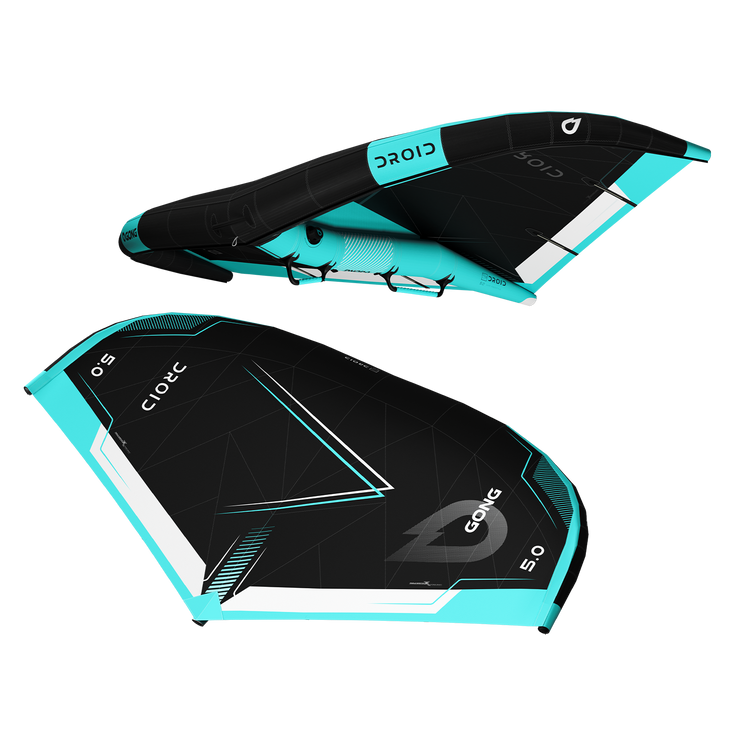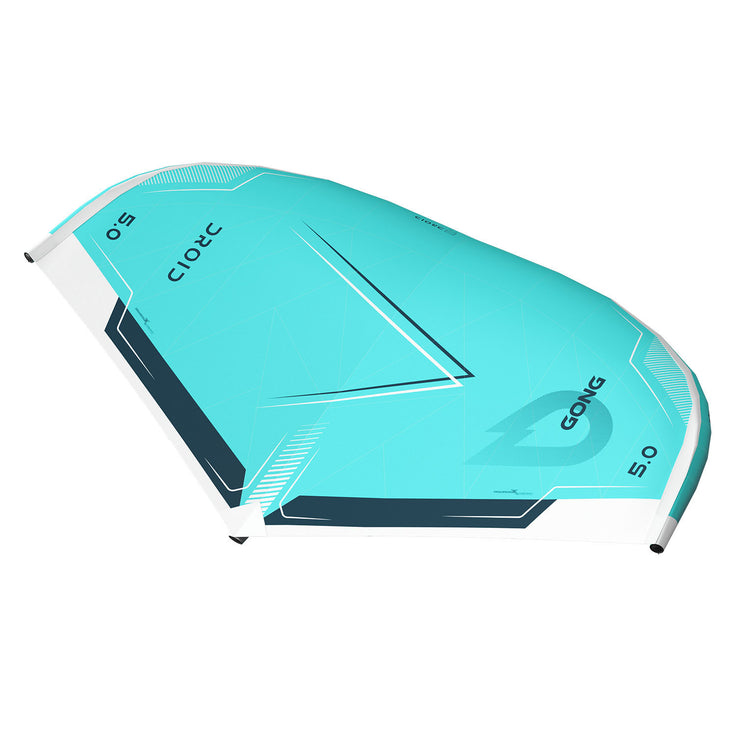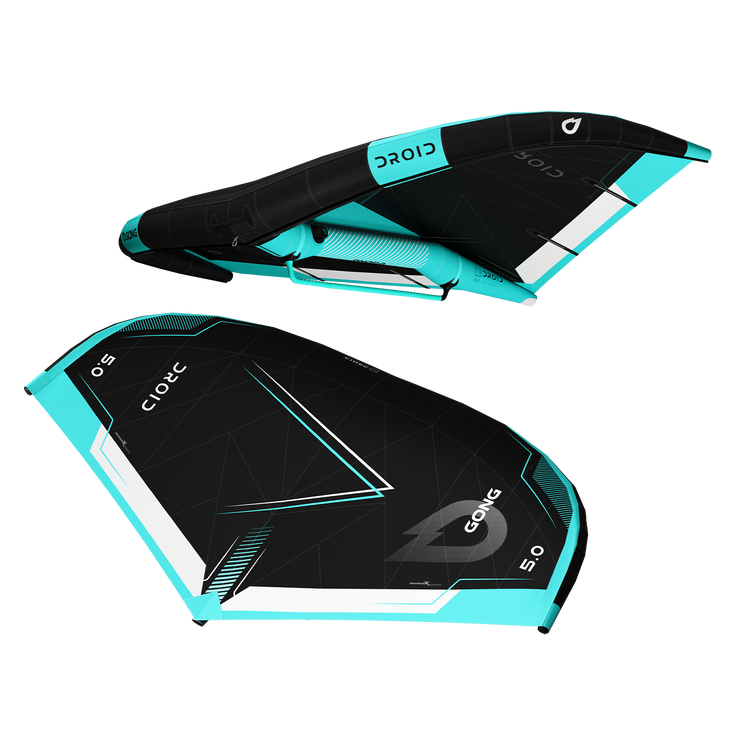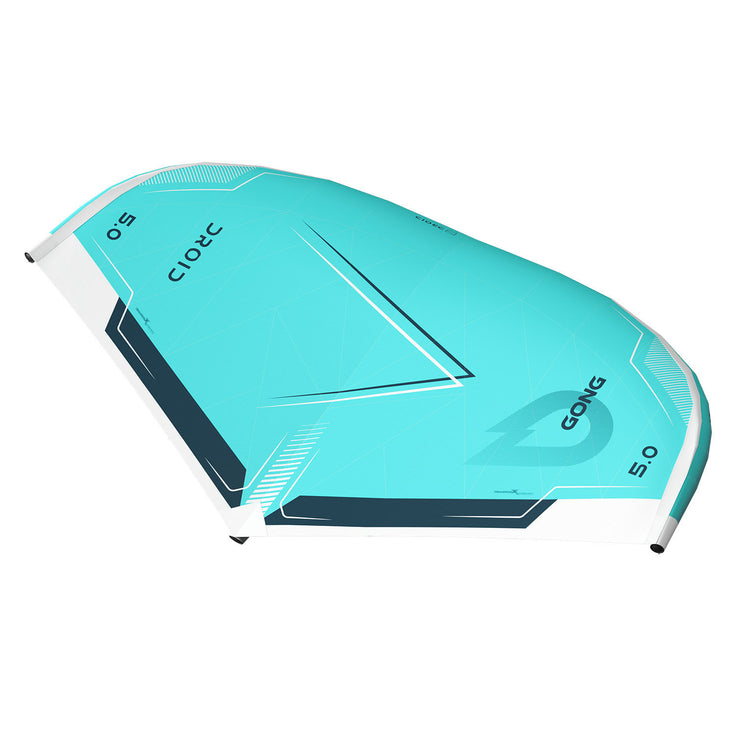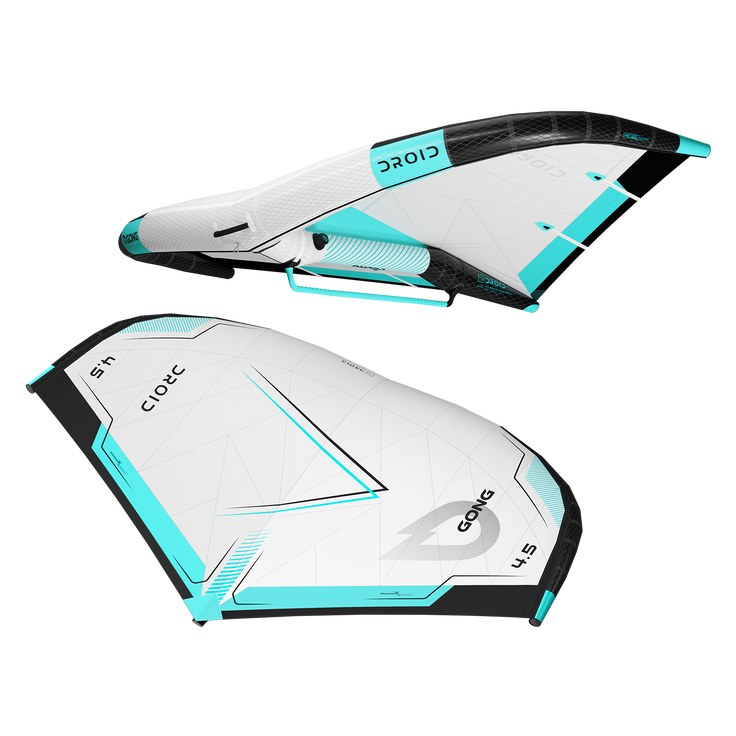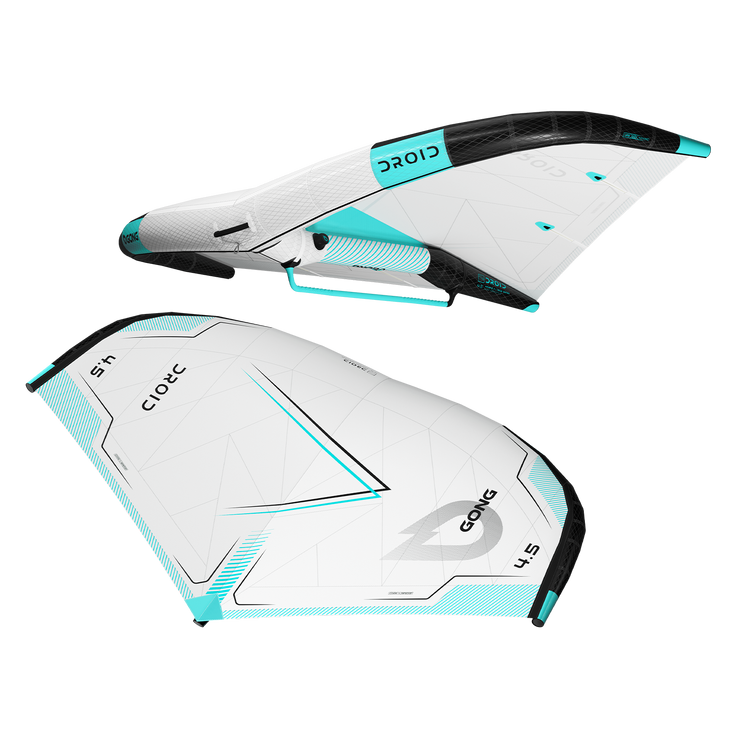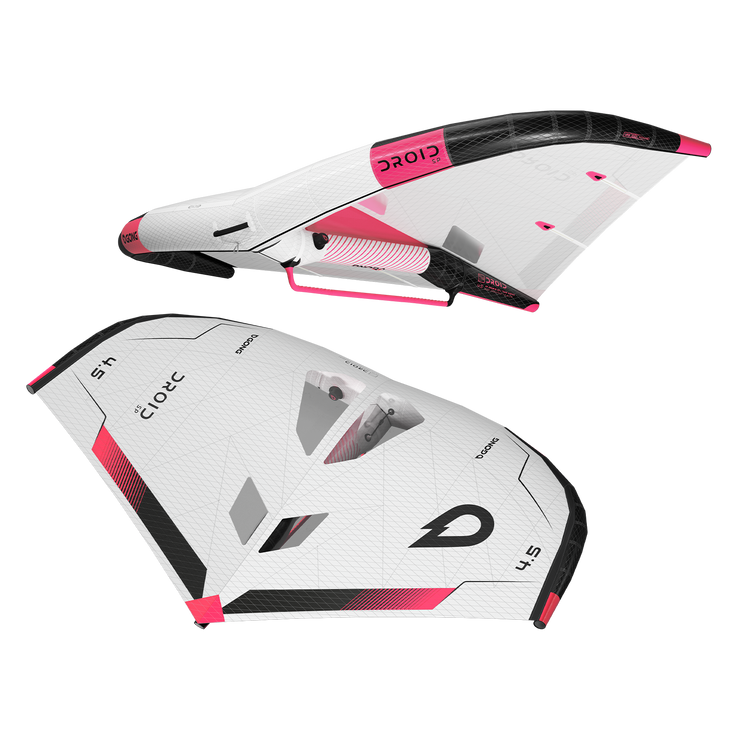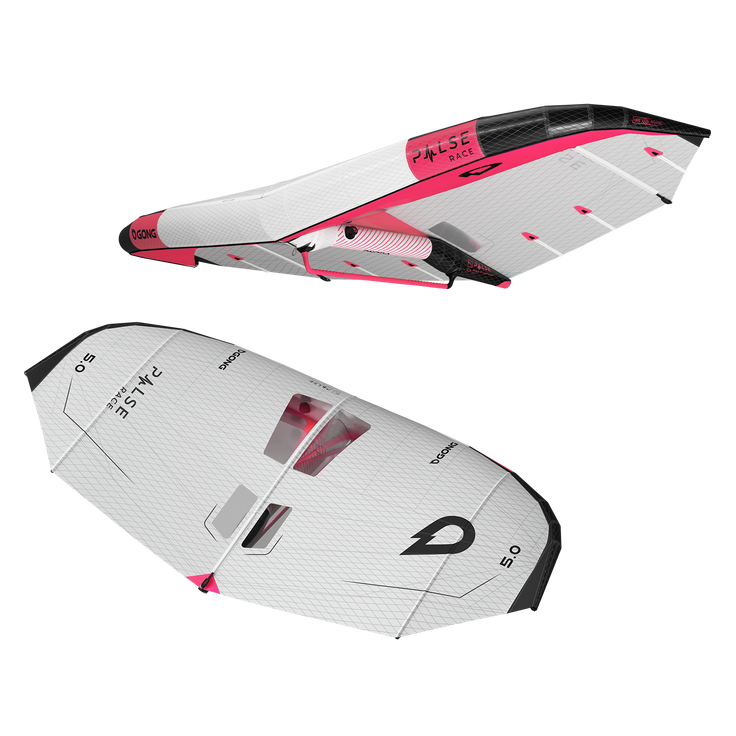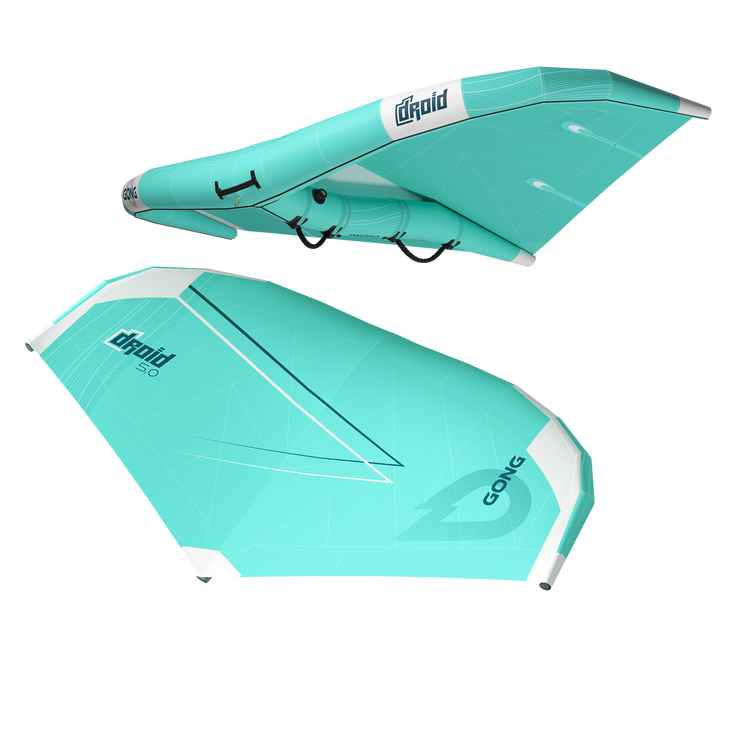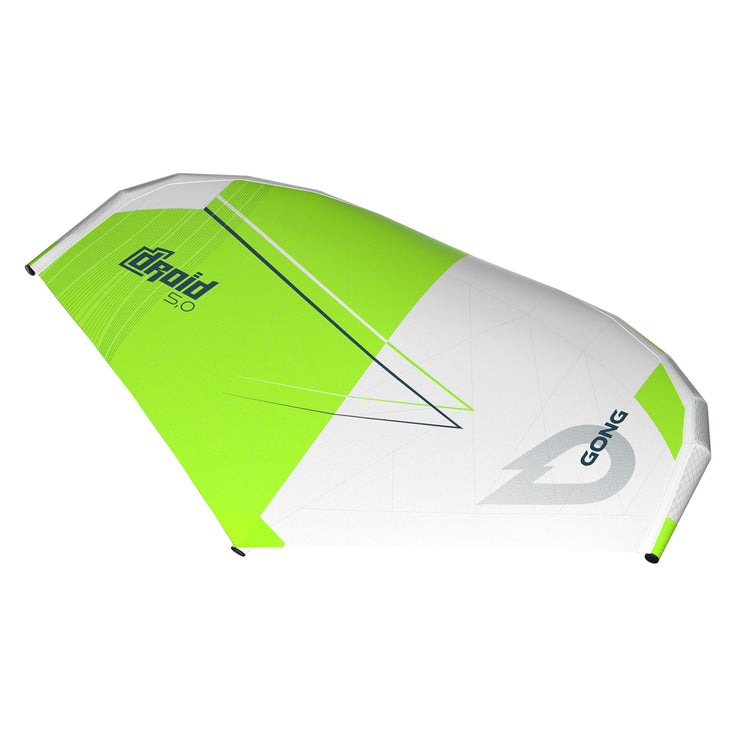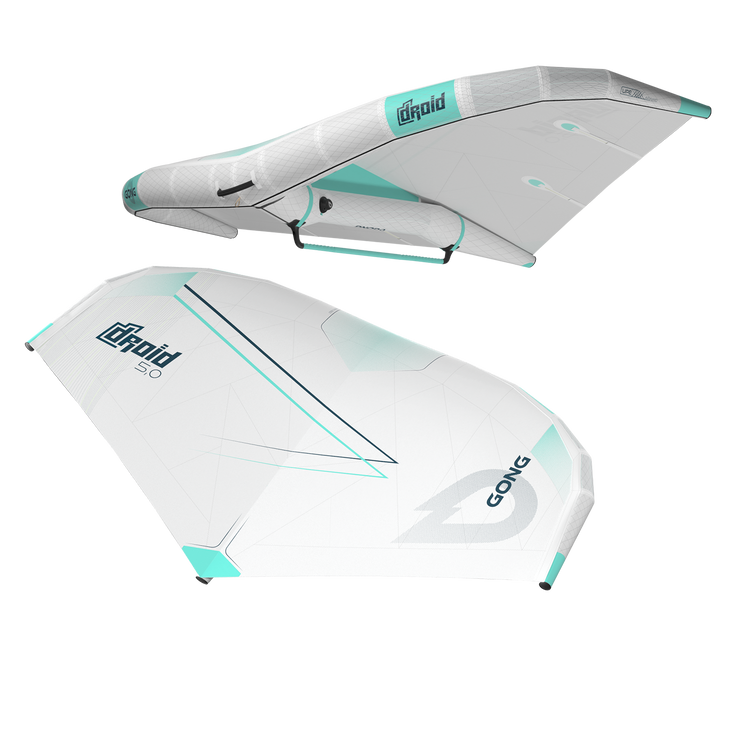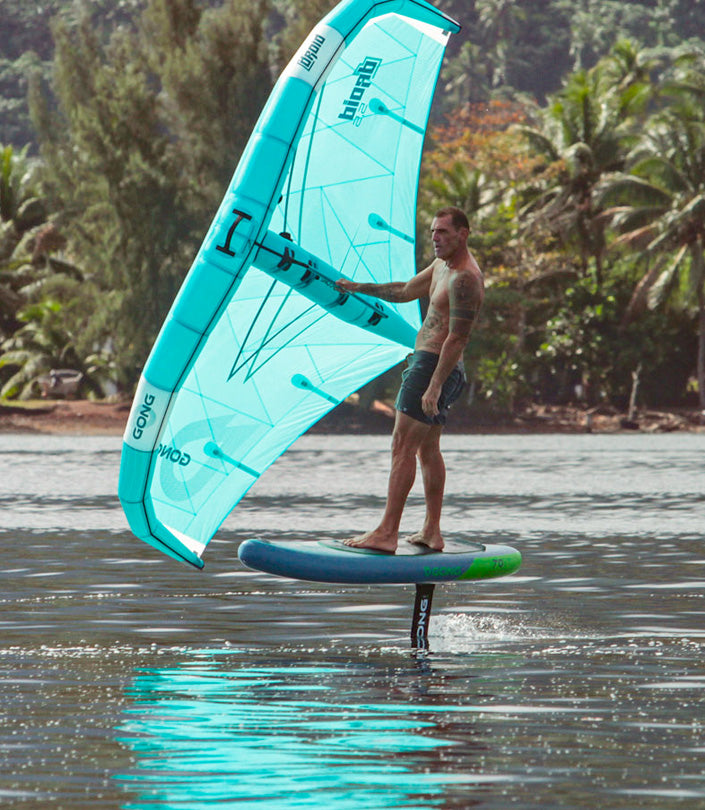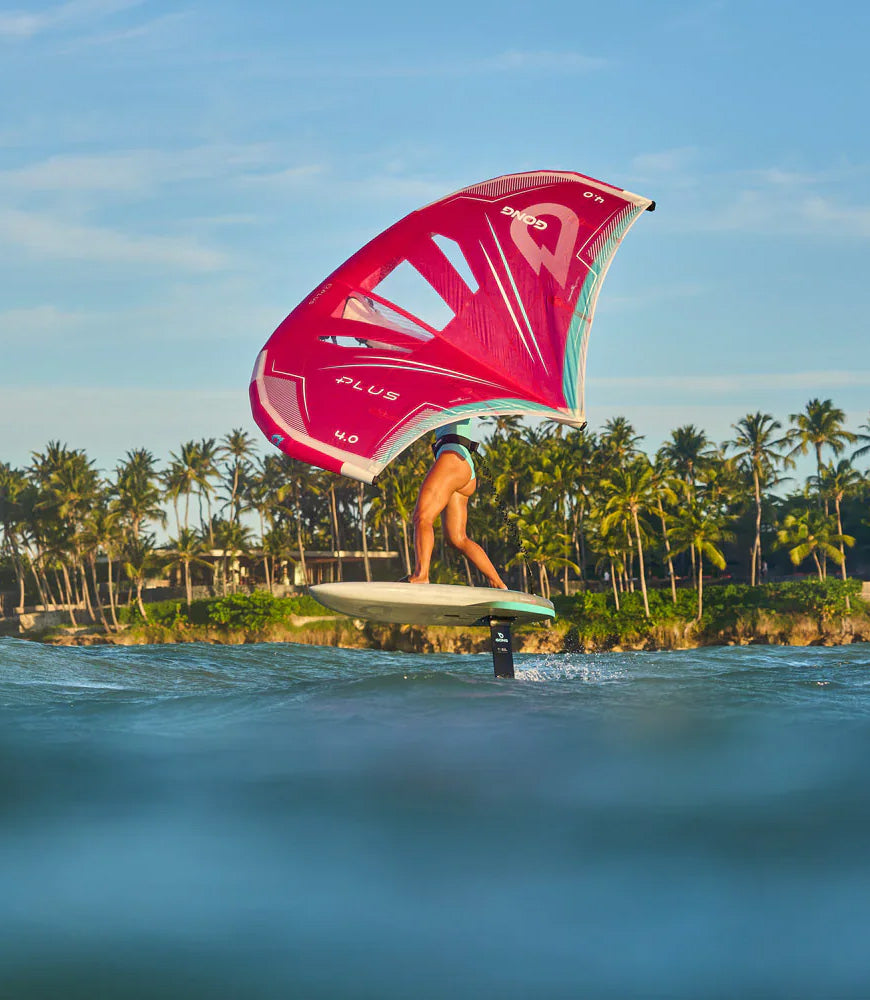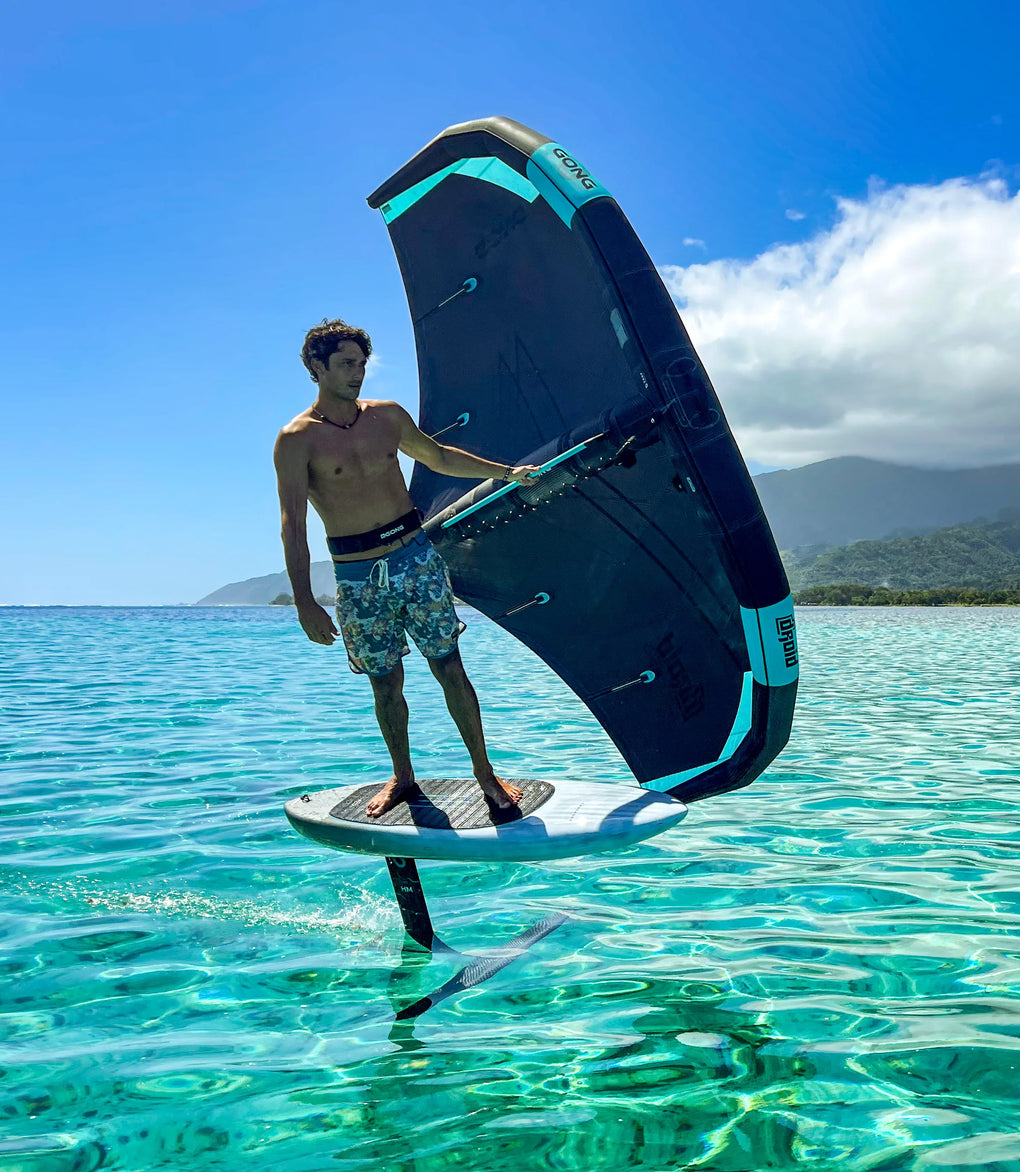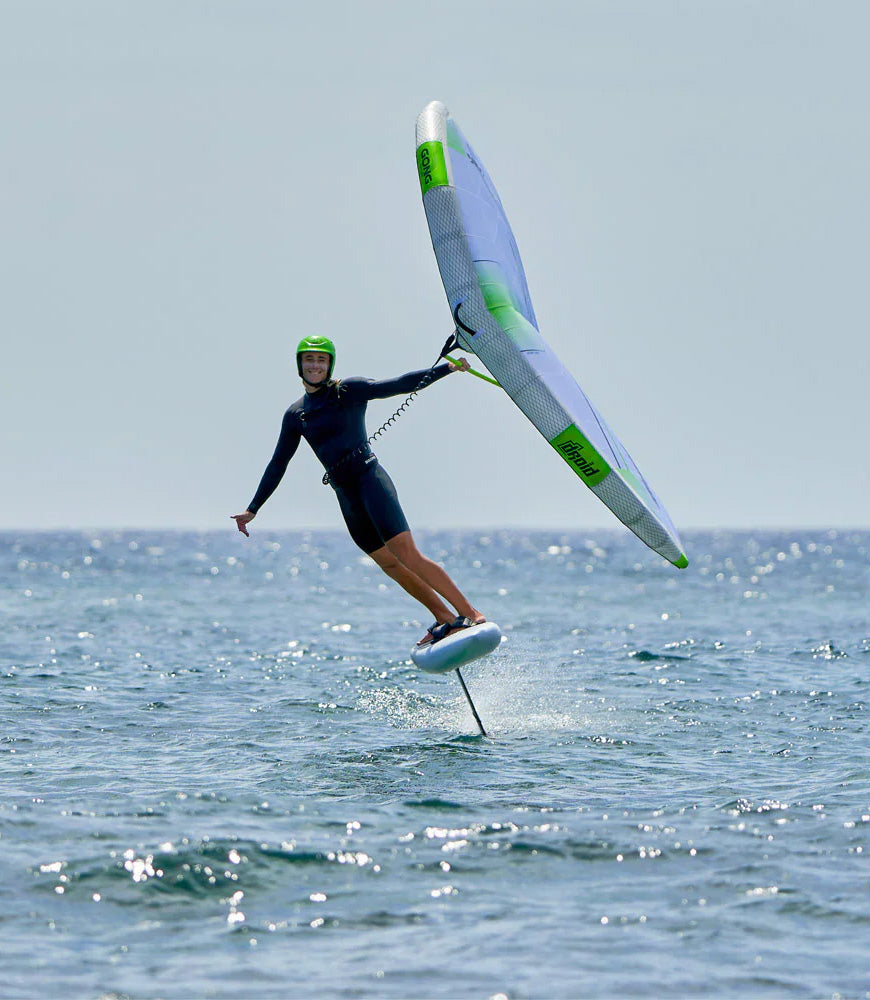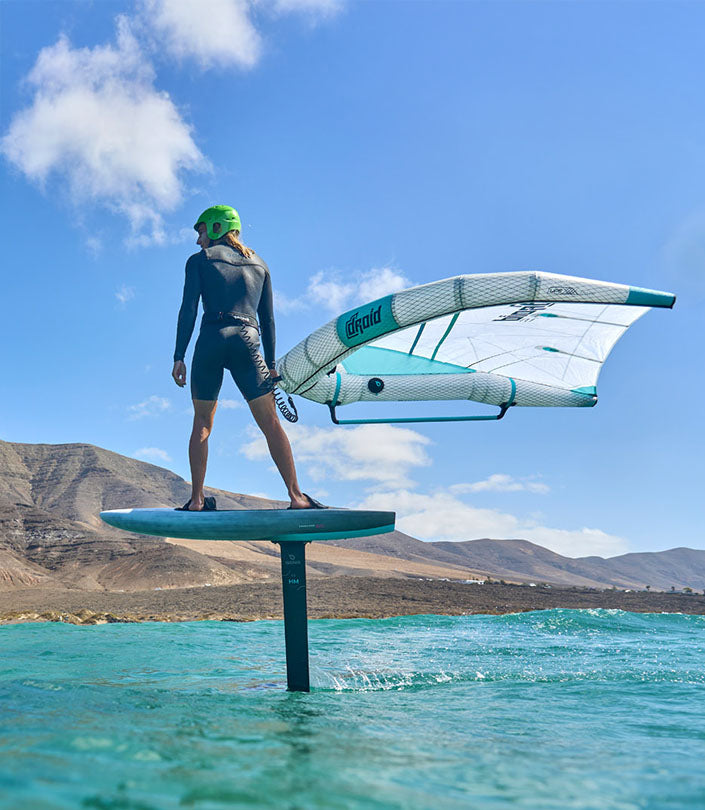Droid Wing
Droid Boom Wing
Wing Droid Aramid
Wing Droid Aramid X
Wing Droid SP Aramid CZ
Wing Pulse Race Aramid CZ
Wing Droid
Wing Droid UPE Aramid
Wing Droid Aramid X
Range presentation
1. Introduction: Wings Designed for Light Winds
Sailing in light winds is an exciting challenge: pushing boundaries, exploring new horizons in silence, enjoying every breath of air, and never wondering again if it's possible to sail or not.
At GONG, we have developed a revolutionary approach with a complete range of boards, foils, and wings designed specifically for these unique conditions. Crafted to maximize every gust, our light wind wings let you sail efficiently and enjoyably, even when the wind is faint.
2. The Genesis of GONG Wings for Light Wind
Light winds demand specific equipment that combines glide, power, lift, lightness, and responsiveness.
For over 25 years, GONG has been innovating to meet riders' expectations and eliminate frustration with ever more efficient products.
Our light wind wings, such as the SuperPower Perf and Pulse Aramid X, embody this pioneering spirit. The Droid brings these features together in a single wing.
Designed with advanced materials and optimized designs, they deliver immediate power and effortless glide, turning marginal conditions into memorable sessions.
3. Features of GONG Wings for Light Wind
- Power: Wings designed to generate maximum traction from the faintest breezes.
- Lightness: High-performance materials ensure exceptional pumping in weak conditions.
- Efficiency: Optimized profiles capture every breath of wind and maintain consistent glide while generating strong apparent wind.
- Stability: Wings providing predictable traction, even in irregular winds or inland waters.
- Durability: Robust construction designed to withstand extended and repeated sessions with intense pumping.
- Versatility: Models suitable for freeride, racing, surfing, or freestyle in light wind conditions.
4. Detailed Comparisons and Tips for Light Wind
Every GONG wing works in light wind, but some are specifically tailored to these conditions. Below is a comparison of the advantages of each model:
Perf Series
SuperPower Perf
- Advantages: Maximum traction and immediate power, ideal for getting on the water in marginal conditions.
- For Whom: Riders seeking an ultra-powerful wing to sail from 5–6 knots without intense pumping, thanks to its inherent power.
- Why It's Ideal: Its deeply curved and compact shape provides immense support even in challenging winds.
Pulse Perf
- Advantages: More oriented toward Vmax and Slalom/Race than the SuperPower, it offers excellent glide in apparent wind for active riders.
- For Whom: Those looking to excel in light wind, go upwind, and race at high speed.
- Why It's Ideal: Its ultimate glide and fine-tuned behavior maintain speed even in lulls.
Droid Perf
- Advantages: Compact and responsive, it excels in light winds with dynamic performance for technical riders.
- For Whom: Those seeking a wing for efficient navigation and playfulness in light winds.
- Why It's Ideal: Its maneuverability is perfect for blending styles in light wind.
Team Series
Droid Aramid
- Advantages: Incredible dynamism, lightweight, and forward-pulling power for performance in marginal conditions.
- For Whom: Experienced riders seeking a forgiving yet high-performance wing for enhancing light wind sessions.
- Why It's Ideal: Its lightness, robustness, and responsiveness make it a magical wing for demanding riders.
Pulse Aramid
- Advantages: 100% focused on Vmax and Slalom/Race, offering exceptional glide in apparent wind for active riders.
- For Whom: Those who want to excel in light wind, go upwind, and race at high speeds.
- Why It's Ideal: Its high-end, rigid construction and absolute glide with 50% Double Profile technology maximize speed and angles even in lulls.
Team Pro
Droid Aramid X
- Advantages: The ultimate wing in terms of rigidity, responsiveness, and performance in light wind.
- For Whom: Expert riders looking for top-notch equipment to maximize their potential, especially in weak winds.
- Why It's Ideal: Its Team Pro construction delivers exceptional performance even in the most marginal conditions, with incredible precision for pumping.
Practical Tips for Light Wind Sailing
- Target Conditions: Light and steady winds (5–12 knots), flat or slightly choppy water, with or without swell.
- Recommended Gear: Choose a very narrow board with significant volume (at least 30L above your weight) and a foil with a large front surface (1,200–2,000 cm²) for maximum lift and a high aspect ratio (>13) to generate the most apparent wind.
- Wing Size: A 5m² to 6m² wing is sufficient to get flying with a narrow board and high aspect ratio foil in 6 knots. Opt for a larger wing (7m² or 8m²) only if using a wide board and low aspect ratio foil to generate enough base power.
- Technique: Be coordinated to synchronize pumping between the wing, the board's rebound, and foil activation to generate speed and take off almost without wind. Once airborne, apparent wind does the rest.
5. Focus on GONG Wing Technology for Light Wind
Navigating in light winds requires addressing specific challenges: capturing every gust, optimizing glide, and ensuring sufficient traction in lulls without compromising maneuverability.
All GONG wings designed for light wind incorporate advanced technologies to meet these demands and deliver a unique experience.
Common Features of All Light Wind Wings:
- Reinforced Canopy: Specially reinforced fabric ensures perfect tension, vital in weak winds, for dynamic traction and immediate response to handling.
- Reinforced Seams: Tested in both labs and on the water, our seams withstand prolonged efforts, even during intense pumping sessions.
- Boom/Handle Reinforcements: Solidly anchored for perfect rigidity, essential in light wind where every movement must be precise.
- Multiple Reinforcements: Materials like Kevlar, Insigna, and Dacron enhance durability for frequent and extended light wind sessions.
- Dedicated Paneling: Optimized panel cuts minimize stretch and unwanted twisting, crucial for maintaining maximum responsiveness.
- Durable Bladders: Designed longer than their sleeves to prevent tearing and tolerate pressure variations, offering essential security for longer rides.
- Meticulous Construction: Every detail is crafted to reduce wear and extend lifespan, even with frequent handling in light conditions.
Dacron (Perf Series)
- Structure: Proven material for excellent tolerance, smooth pumping, and a deeper profile, perfect for variable conditions.
- Canopy: Triple ripstop for durability and lightness.
- Applications: Ideal for intermediate and beginner riders seeking reliable and efficient solutions in light wind.
Aramid (Team Series)
- Structure: Aramid and UPE (Dyneema) offer exceptional resistance and unmatched lightness (85 g/m²).
- Applications: Wings like Pulse Aramid and Droid Aramid suit regular riders seeking performance, lightness, and smoothness.
Aramid X (Team Pro Series)
- Structure: Crosswoven aramid and UPE ensure optimal rigidity and stability under pressure.
- Applications: Droid Aramid X is perfect for experts pushing boundaries in light wind.
6. Rider Testimonials
SuperPower Perf:
“The wing that gets me on the water when no one else is out. Incredible traction from 6 knots!”
“Perfect for light wind; it takes off early and is pleasant to handle.”
Pulse Perf:
“A fast wing, perfect for combining light wind and speed.”
“Its behavior is ideal for staying steady in gusts and lulls.”
Droid Aramid X:
“The best for performing in ultra-light winds. Impressive responsiveness and rigidity.”
7. FAQ: Frequently Asked Questions About Light Wind
Q: Which wing is best for progressing in light wind?
A: The SuperPower Perf is ideal for its power and tolerance in lulls. The Droid excels in pumping, versatility, and simplicity.
Q: Can a light wind wing be used in medium winds?
A: Yes, but they are optimized for weak winds and may become technical and demanding in stronger winds.
Q: What size is best for light wind?
A: We recommend 5m² to 6m² on a narrow board with a high aspect ratio foil. Larger sizes (7m² or more) are needed for wide boards with low aspect ratio foils.
Q: Are light wind wings suitable for freestyle?
A: Yes, models like the Droid Perf or Aramid offer excellent maneuverability for tricks in light wind.
Q: How can I extend my wing's lifespan?
A: Let it dry in the shade, store it carefully, and regularly check seams and reinforcements. Avoid leaving it in direct sunlight, especially at full pressure.
8. Conclusion: The Ideal Wings for Your Light Wind Sessions
GONG wings for light wind, like the SuperPower Perf and Pulse Aramid X, perfectly combine power, lightness, and durability. Whether beginner or expert, these wings push the limits of what's possible in light wind.
With advanced materials, meticulous construction, and direct-to-consumer pricing, these wings turn every light wind session into pure joy. Enjoy every breeze with GONG!
Shapes, dimensions and program
Understanding the Elements That Influence Your Wing's Performance and Feel
Understanding the factors that influence your wing's performance and feel is essential to choosing the perfect model.
Here are the key parameters to refine your choice:
Technical Parameters That Influence Performance
1. Camber
Camber determines the type of power generated by the wing.
- A pronounced camber provides more power for early takeoff, ideal in light wind conditions or for beginner riders seeking traction.
- A reduced camber prioritizes speed and stability in the high wind range, perfect for competitions or sessions in strong wind.
- A forward camber facilitates takeoff and generates more direct traction, offering a constant sense of control. It is ideal for marginal conditions or for riders seeking maximum lift.
- A recessed camber promotes smoother glide, making it particularly suitable for disciplines where finesse and speed are key, such as racing or wave riding.
2. Dihedral Angle
The dihedral corresponds to the angle formed by the two halves of the wing when viewed flat from the front.
- A pronounced dihedral makes flips easier, reduces power, simplifies tension and the appearance of the wing, and keeps the tips away from the water.
- A reduced dihedral improves aerodynamic efficiency, maneuverability, precision, and power but requires more precise work on tension.
3. Span
The span influences stability and maneuverability.
- A large span stabilizes and smooths the flight and optimizes glide.
- A reduced span increases power, enhances rotation and agility, and is ideal for freestyle or wave riding.
4. Aspect Ratio
The aspect ratio (span divided by width) directly impacts the wing’s behavior.
- A high aspect ratio promotes glide, speed, and directional stability.
- A low aspect ratio makes the wing more maneuverable, torque-rich, and accessible, making it perfect for beginners or freestyle.
5. Canopy Tension
The tension applied to the canopy directly impacts the stability and feel of the wing.
- High tension maintains the wing’s shape at its maximum efficiency, offering precise handling and increased stability, even in gusts. It is ideal for technical riders seeking maximum performance and consistent behavior.
- Soft tension allows the wing to "breathe" and adapt to wind variations, relieving the rider during long sessions or in irregular conditions. This is perfect for more comfortable freeriding but may lead to flapping and instability. A wing that self-regulates is good; a wing that deforms uncontrollably is not.
6. Leading Edge Curve
The curve affects rigidity and force distribution.
- A pronounced curve generates more power and improves low-end stability.
- A flatter curve increases maximum speed and responsiveness.
7. Trailing Edge Curve
- Positive curve (curved backward): Promotes power and efficiency during pumping but risks excessive flapping.
- Negative curve (curved forward): Reduces drag and flapping, ensuring maximum performance when properly powered.
8. Tip Shape
- Wide tips improve stability during takeoff and simplify control.
- Narrow tips reduce drag and enhance maneuverability but require more technical skill.
9. Tip Twist
The twist influences the distribution of power.
- Pronounced twist provides better control in gusty winds.
- Reduced twist maximizes power but can become difficult to handle in high wind ranges.
10. Panel Cut Design
The cut of the panels influences canopy tension and load distribution.
- Well-adjusted panels ensure shape stability and a more durable performance level.
- Multiple panels allow easier masking of potential repairs.
- However, more panels increase weight and cost due to longer stitching lengths.
11. Leading Edge Diameter
- A wide leading edge in the center improves structural rigidity and resistance to flex, increasing power but adding weight and drag.
- A thinner leading edge in the center allows for more flex, requiring higher inflation pressure. It results in a more refined profile.
- At the tips, a thinner diameter reduces drag and enhances maneuverability.
12. Central Strut Connection to Leading Edge
- A strong central strut connection to the leading edge limits tip twist, increasing responsiveness and power transfer to the rider. It also prevents trailing edge flapping.
- A weaker connection allows more twist, increasing tolerance and self-regulation, but it must be well-controlled.
13. Central Strut Shape
- A rigid central strut increases responsiveness and power transfer to the rider.
- A softer strut offers greater tolerance in changing conditions, allowing the trailing edge to open. However, this can lead to flapping and variations in the center of the power point.
14. Presence of Additional Battens
- Some wings incorporate side battens to increase rigidity and improve control.
- This increases weight and reduces maneuverability.
15. Anti-Vibration Battens on the Trailing Edge
- These specific battens reduce flutter and ensure silent and stable glide, improving durability.
Adapt Your Wing to Your Style and Needs
The above characteristics must be considered based on your program (racing, freestyle, wave riding, etc.) and the conditions in which you ride.
- A freestyle rider will favor a compact and responsive wing.
- A free-fly enthusiast will look for a stable and lightweight wing.
These elements shape the essence of each model, directly influencing its performance and feel on the water. You now have the tools to choose the wing that perfectly matches your ambitions.
DACRON Wing Technology
DACRON Wing technology
Our wings are made in one of the two largest kite and wing factories in the world according to the quality standards of the best wings.
They are built with the greatest care. The panels are CNC cut and entirely assembled by hand by the best workers in the kite industry.
The materials we use for our wings are among the finest. We are looking for performance of course but we also want endurance and therefore materials that have proven themselves:
- Leading edge and central strut in very rigid and durable Dacron DP175LL.
- Top of the range triple Ripstop spinnaker for anti propagation of tears in 54g/m2.
- Insigna reinforcements on all seams for greater durability.
- Tip saver in 1680D Nylon to protect against friction on the tips.
- Kevlar reinforcements under the handle/boom attachments on the central strut.
- 80 micron thick TPU cushions.
- One Pump system for quickly inflating and deflating.
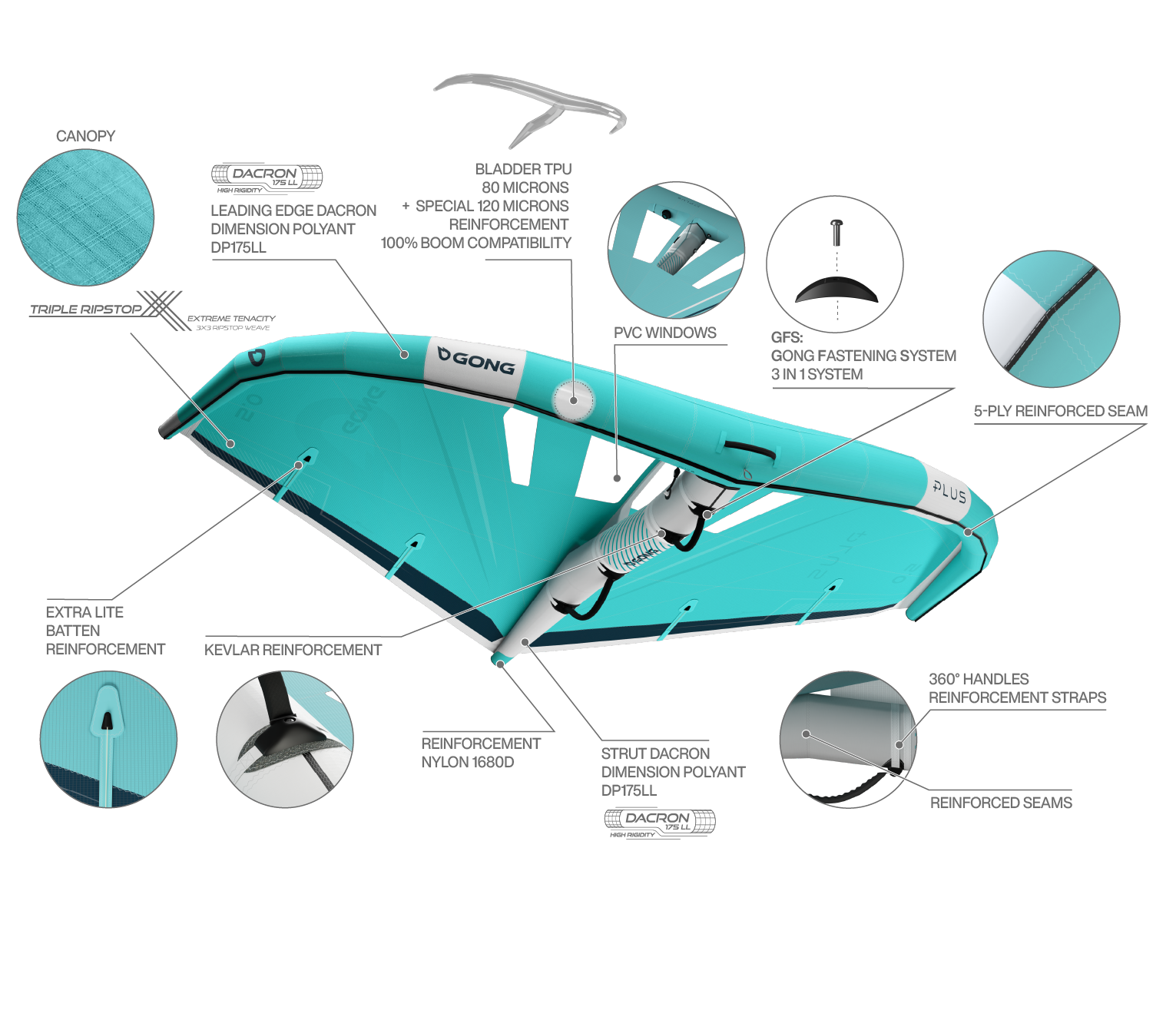
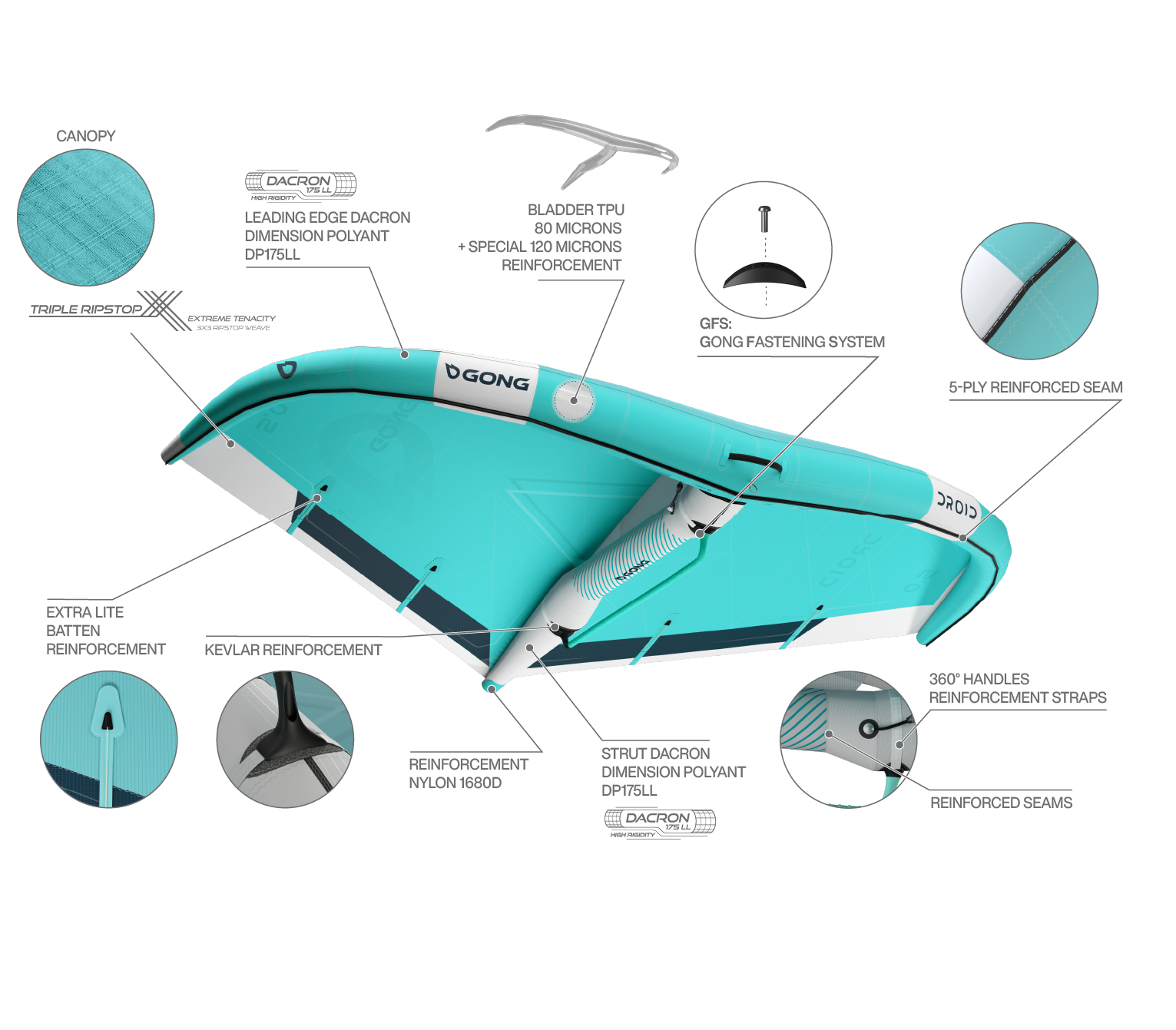
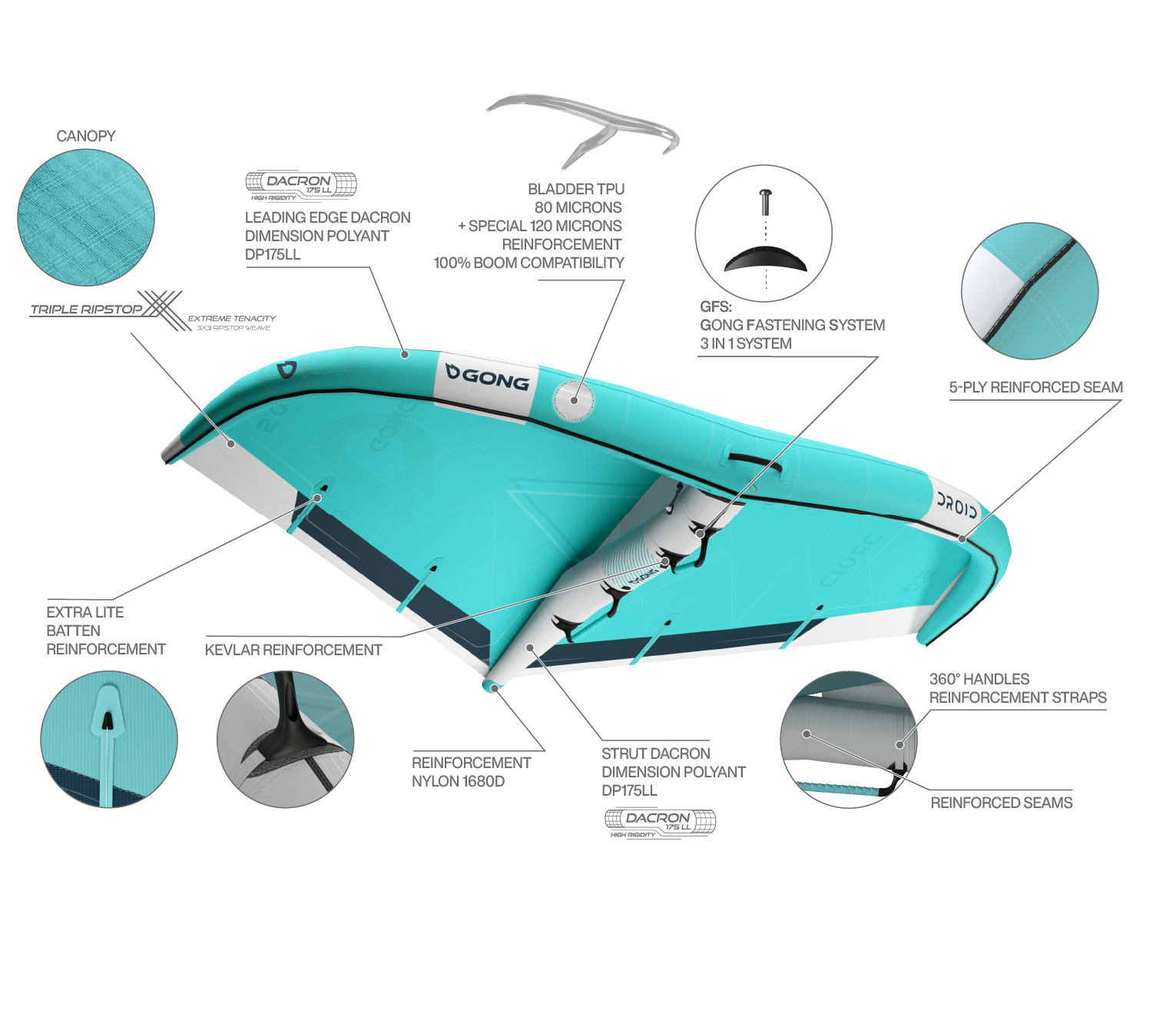
Aramid Technology
The inflatable structural material known as "Aramid" has the following characteristics:
- Weight: 85 g/m².
- Structure: UPE (Ultra-Polyethylene), also known as Dyneema.
- Anti-stretch reinforcements: Crossed aramid fibers.
Component Properties:
- UPE (Dyneema): This polymer is renowned for its exceptional tensile strength, light weight, and durability. It offers excellent abrasion and UV resistance, making it ideal for applications requiring high robustness while maintaining optimal lightness.
- Aramid fibers: Known for their high tensile strength and low elongation, aramid fibers, such as Kevlar, are used to reinforce structures by limiting deformation under stress. They also provide good heat and cut resistance.
Effects on the Structure:
The combination of UPE and aramid fibers in the "Project 85" material gives the inflatable structure an optimal balance of lightness and strength. UPE provides a solid and durable base, while the aramid fiber reinforcements limit stretching, ensuring dimensional stability under pressure. This synergy results in a structure capable of withstanding mechanical stresses while maintaining the flexibility necessary for inflatable use.
Key Qualities:
- Lightweight: With a weight of 85 g/m², the material remains light, facilitating transport and handling of the inflatable structure.
- Mechanical resistance: The combination of the two fibers enhances resistance to tensile forces and deformations, thereby extending the product's lifespan.
- Durability: The UV and abrasion resistance of UPE, combined with the robustness of aramid fibers, ensures longevity even under intensive use or in demanding environments.
In summary, "Aramid" is a high-performance material combining lightness and strength, making it ideal for applications requiring a lightweight, robust, and durable inflatable structure.
ARAMID X technology
The UPE Aramid X wings feature the most advanced technology on the leading edge and the strut.
The UPE Aramid, a true gem of textile technology developed by experts in nautical textiles
How does it work?
- The PET film ensures the connection between the elements and waterproofing.
- The Aramid fibers are arranged at a chosen angle to block the fabric’s extension under load without unnecessarily adding weight to the structure
- The thin layer of UPE, lighter than on UPE 200, ensures strength. This tight weave of Dyneema fibers is a veritable shield.
- These three laminated layers create a fabric that is both extremely lightweight, highly rigid, and very resistant to tearing.
- Our exclusive assembly, tested in the laboratory and by the Pro Team, ensures unparalleled longevity for UPE Aramid.
The whole system is so rigid that 8 PSI gives you the rigidity of a UPE 200 at 15 PSI. It’s truly deformation-resistant.
Less pressure = less stress in the wing = less time spent pumping.
More durability, performance, and lightness: the holy grail.
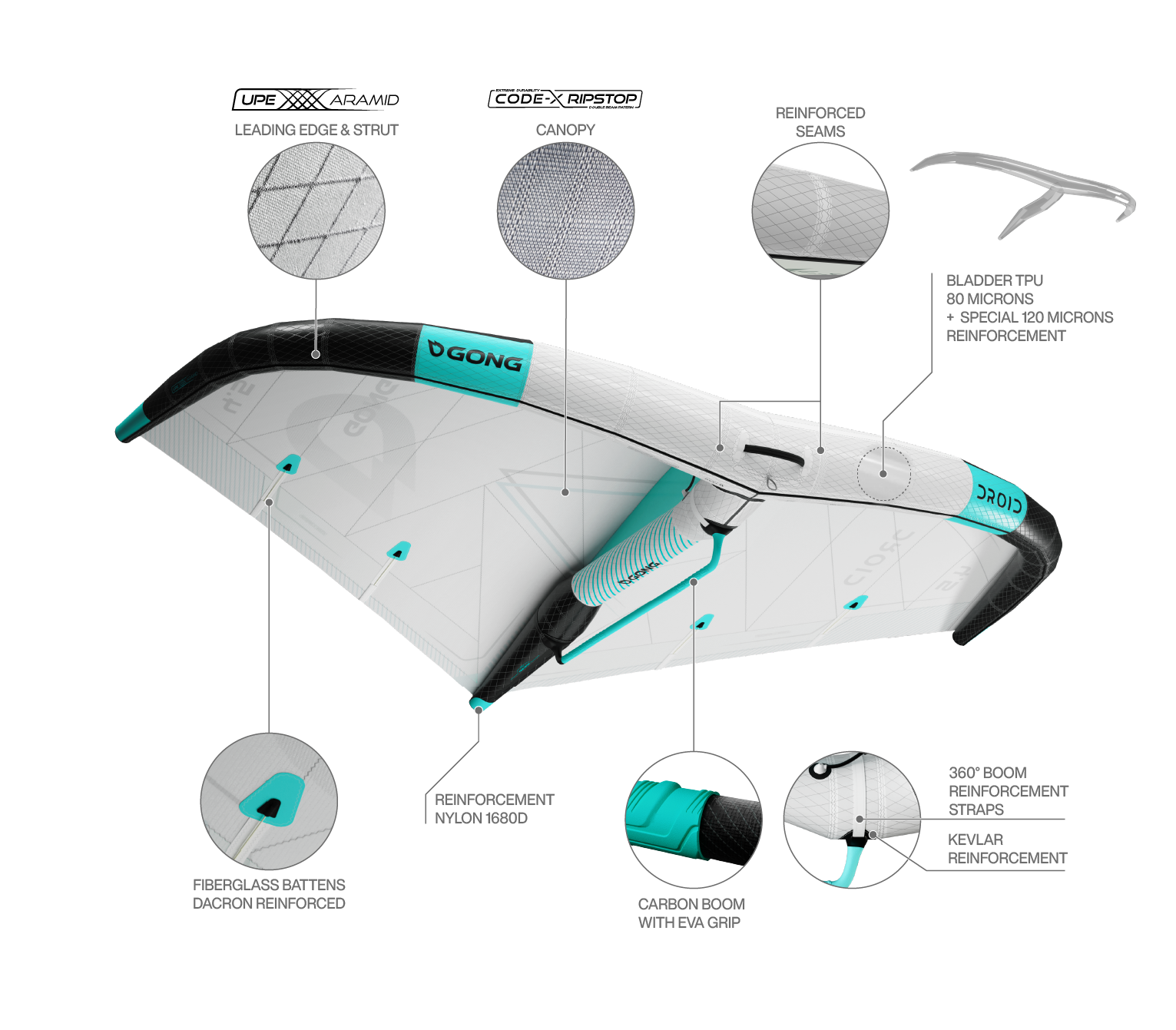
Good to know
Tips and Advice to Optimize Your Wing Usage
Here are the essential points and best practices to maximize your performance in wingfoil and extend the lifespan of your equipment:
1. Adjust Inflation and Pressure
- Strictly follow the recommended pressure guidelines to optimize the wing's rigidity.
- Underinflation leads to performance loss, less precise shape, and can cause flapping.
- Always inflate to the maximum recommended pressure using an appropriate pump (dual action for initial inflation, single action for finalizing).
2. Proper Wing Maintenance
- Rinsing: Avoid systematically rinsing with fresh water, as salt can help prevent mold. If you rinse, do so sparingly to avoid damage from chlorine.
- Drying: Prefer drying the wing flat or inflated to prevent bladder displacement. Never hang a deflated wing by a handle.
- Storage: Store your wing away from sunlight, humidity, and extreme temperatures. Excessive heat or cold can degrade the materials.
3. Handling and Precautions
- On the beach: Place your wing on a clean surface, away from sharp or puncturing objects.
- While riding: Keep the wing out of the water as much as possible, especially in waves. A fall in waves can severely damage the fabric and seams.
- With a foil: Avoid any contact between the wing and the foil. A stabilizer or front wing can puncture the fabric instantly.
4. Maximizing Performance According to Conditions
- Light wind: Use a wing with pronounced camber to generate more power and make takeoff easier.
- Strong wind: Opt for a wing with a taut canopy for increased stability and better gust management.
- Cold water: Use a slightly larger wing to offset the extra weight of your gear.
5. In Case of a Fall or Emergency
- Use your wing to swim faster: Keep the leading edge facing the water, grab the wing, and let it inflate with the wind to provide additional support.
- Regularly inspect your leash before and after each session to avoid unexpected breakage.
6. Maintaining Wings with Windows
- Roll the ends toward the central strut to avoid pinching the PVC in the window.
- Store them dry to prevent color transfer between fabrics and PVC.
7. Safety and Responsible Riding
- Conditions: Ride in side or onshore wind conditions to ensure an easy return to shore if problems arise. Avoid offshore winds without secure assistance.
- Right of way and distance: Respect the right-of-way rules on the water and maintain a safe distance from other users.
- Safety gear: Wear a helmet, an impact vest, and always use a leash.
8. Specific Points for Long-Term Storage
- If not using the wing for an extended period, inspect the bladders and valves before your next session.
- Avoid excessive folding to preserve the integrity of seams and materials.
9. Common Sense and Good Seamanship
- Be aware of weather forecasts and currents.
- Never use a wing as a parachute or hang glider.
- Respect nature and help others in need, always with caution.
These recommendations are designed to support safe and efficient riding while ensuring the longevity of your wing. Be sure to adjust these tips based on your needs and the specifics of your sessions.








